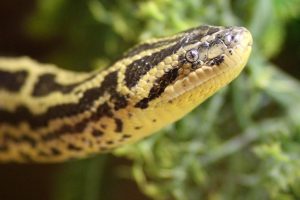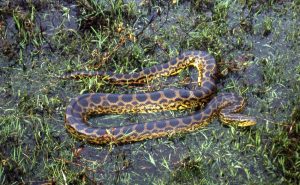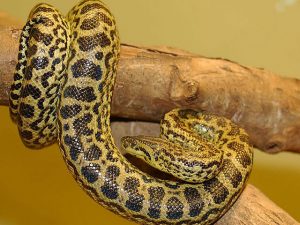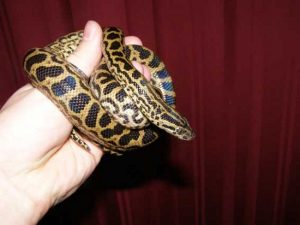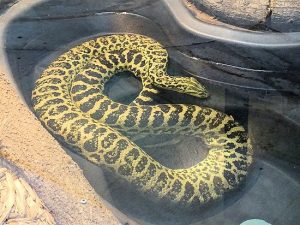Yellow Anaconda
One of the four species of anaconda, yellow anaconda is a large snake common in South American regions. Their appearance and temperament are the main reasons that many zoo authorities keep them as exhibits. They are dangerous when intimidated by humans encounter.
Scientific Classification
| Kingdom | Animalia |
| Phylum | Chordata |
| Class | Reptilia |
| Order | Squamata |
| Suborder | Serpentes |
| Family | Boidae |
| Genus | Eunectes |
| Scientific Name | Eunectes notaeus |
Quick Information
| Also known as | Paraguayan anaconda |
| Description | Size: 10-15 ft (3-4.5 m) Weight: 55-80 lb (25-36 kg) Color: Yellow-green body with dark brown or black oval patches Sexual Dimorphism: Females are larger |
| Distribution | Bolivia, Paraguay, northeastern Argentina, and western Brazil |
| Habitat | Marshlands and swamps, sometimes in forests for hunting, caves during the draught |
| Mode of Communication | Tactile and chemical means |
| Lifespan | 15-20 in the wild and around 23 years in captivity |
| Diet | Turtles, birds, eggs of birds, fish, deer and pig-like animals besides small mammals |
| Adaptation | The oval patterns on the snake’s body help them camouflage inside forest vegetation and water |
| Predators | Adult anacondas are hunted by poachers while vulnerable juvenile anacondas are consumed by larger anacondas and different species of crocodiles |
| IUCN Conservation Status | Not listed |
Behavior
- The snake remains solitary throughout its life except during the mating season.
- Although a constrictor, yellow anaconda hunts from the water and its victims die out of drowning most of the time.
- The snake unhinges its jaw to consume animals larger than their mouth.
- It uses heat-sensing pit located inside its mouth to perceive the proximity of other animals.
- The yellow anaconda lives in aquatic regions and comes to land either for mating or for hunting.
Mating and Reproduction
Female yellow anacondas release pheromones and attracted by it, males follow the females and create a breeding ball including multiple males and only one female. The males compete with each other and the strongest one wins and gets to mate with the female. The courtship is known to last for a month and the breeding season is during April and May. After 6 months of gestation period while the eggs hatch inside the mother’s body the female gives birth to baby snakes ranging from 4 to 80 in numbers.
Life-cycle
Young anacondas sizing 23 inches are self-dependent right from their birth and they attain sexual maturity at the age of 3-4 years.
Interesting Fact
- Their scientific name Eunectes notaeus are Greek words meaning good swimmer and dorsal respectively.
References
Published on December 7th 2018 by Sahana Kanjilal under Coniferous Forest Animals.
Article was last reviewed on 5th December 2024.



